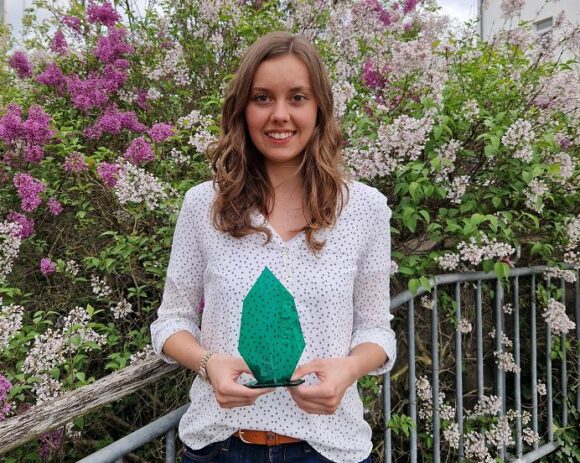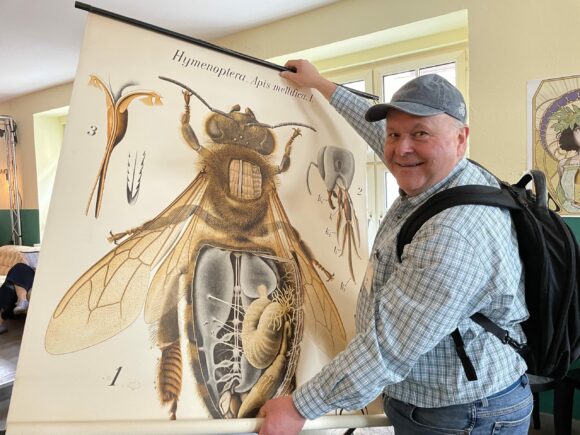A doctoral thesis on the development of new technical, hydroentangled nonwovens is currently being written at the new Nonwovens Development Center (VEZ) on the Münchberg campus of Hof University of Applied Sciences. The dissertation is entitled “Study on the development of hydroentangled nonwovens (spunlace) and identification of their applications, particularly in the field of technical textiles” and is being carried out by Biruk Ketema Semu. He is in the final year of his doctorate and is a participant in the Ethiopian-German doctoral scholarship program, in which he represents Ethiopia.

The doctoral program is a collaboration between the German Academic Exchange Service (DAAD) and the Engineering Education Capacity Building Program (EECBP) of the Ethiopian Ministry of Education. The program runs for three years and includes alternating six-month research stays in Germany and Ethiopia. Biruk Ketema Semu is currently completing the fifth semester of his research, which is taking place in Germany. His main supervisor is Professor Oliver Lottes from the Münchberg Campus of Hof University of Applied Sciences, while Professor Dr. Murugesh Babu from the Ethiopian Institute of Textile and Fashion Technology at Bahir Dar University continues to support him.
Spunlace technology as an environmentally friendly production method
Hydroentangled nonwovens are created by mechanically bonding fibers of a nonwoven fabric, which is produced using various web formation techniques. In the process known as hydroentanglement (spunlace), fibers are entangled and bonded together using high-pressure water jets. This produces a uniform, bonded nonwoven fabric, commonly referred to as spunlace in the nonwovens industry. Compared to other nonwoven bonding methods, hydroentanglement is characterized by its sustainability, including the absence of chemical binders. It also enables the use of a wide range of fibers, making it an environmentally friendly option for nonwoven production.

Due to these unique advantages, hydroentanglement technology is very popular for disposable textile applications in the hygiene and medical sectors. However, its potential for technical textile applications has not been extensively researched so far, especially in comparison to its dominant application in the personal and household hygiene products market segment. Therefore, the main objective of this PhD thesis is the investigation and further development of hydroentangled nonwovens and the modification of the process for technical textile applications with improved performance properties.
Innovative pilot studies
In the course of the research study, two innovative experimental pilot studies were carried out after a comprehensive analysis of scientific literature, industrial products and patent applications. The aim was to identify potential categories for technical textile applications and to determine the necessary parameters of the hydroentanglement process.
In the first pilot study, the focus was on product development in the field of hydroentanglement. A hydroentangled nonwoven fabric for use as a seed mat was successfully produced and tested in a laboratory study on the growth of grass seeds. The results indicate that this innovative product could play a significant role in further research in the field of agrotech technical textiles, as well as a component of green roof products.
“The challenges of climate change are immense – in the field of agrotech, agriculture, many things need to be changed, for example controlled plant growth, controlled and thus reduced water supply, early harvesting or erosion protection. Nonwovens offer great potential for this.”
Prof. Oliver Lottes
The second experimental study focused on the further development of the hydroentanglement process. An innovative approach was implemented to maximize the formation of micro- and nanofibres by fibrillating cellulose fibres. “By fibrillating fibers during the hydroentanglement process, microstructures can be created that generate a significant improvement in the quality of the spunlace nonwoven for filter applications, for example,” explains Prof. Lottes.
This progress in the hydroentanglement process, especially for nanofibers, has the potential to create a new technological platform for product innovations.
Cooperation partners
The practical implementation of the experimental part of the doctoral thesis is supported by collaborations with leading companies in the industry, such as Trützschler Nonwovens, Rudolf GmbH, Groz-Beckert KG and LENZING AG. These companies not only provide new experimental materials, but also valuable technical expertise. After successfully completing his research studies, Biruk Ketema Semu will be awarded a doctorate by Bahir Dar University in Bahir Dar, Ethiopia.







